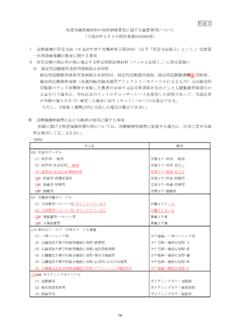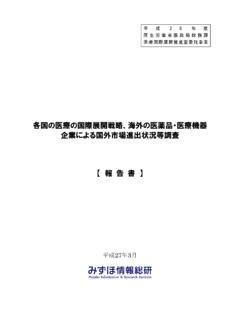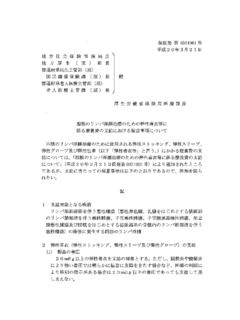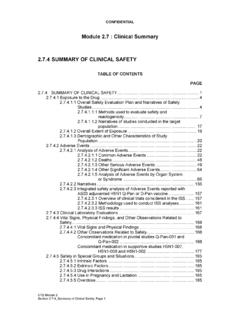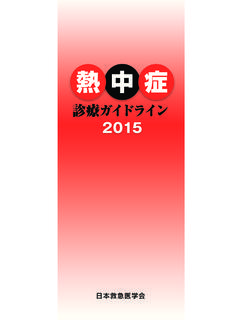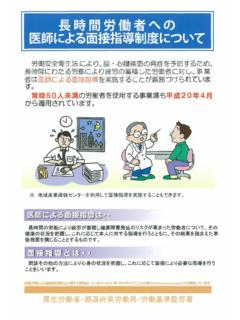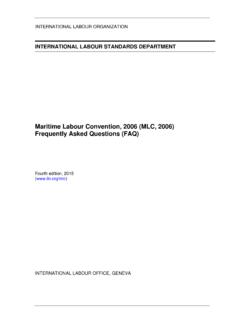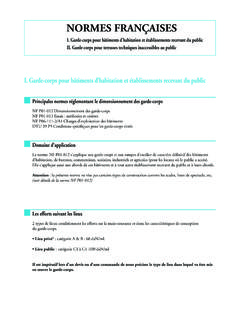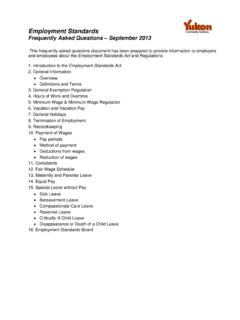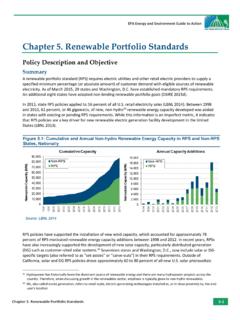Transcription of New Standard limits for RadionuclidesRadionuclidesin ...
1 This is provisional translation. Please refer to the original text written in Standard limits for New Standard limits for RadionuclidesRadionuclides in Foodsin FoodsDepartmentofFoodSafetyDepartmentofF oodSafetyPharmaceutical & Food Safety BureauMinistryofHealthLabourandWelfareMi nistry of Health, Labour and Welfare MinistryofHealth,LabourandWelfare1 The current provisional regulation values were established based on the concept The concept of Current Provisional regulation Values The current provisional regulation values were established based on the concept shown below, in line with index relating to the restriction of food intake derived by the Nuclear Safety Commission under assumption of nuclear power plant ) Set the annual maximum permissible dose from radioactive cesium in foods as 5mSv and assign to each food ) Assuming that people continue to consume contaminated foods for a long time derive regulatory values based on the intakes according to foodtime, derive regulatory values, based on the intakes according to food categories, so that the permissible dose is not exceeded.
2 Note: Apply the lowest levels which are obtained by taking into consideration the intake and susceptibility of the groups of adults, young children, and infants to all age The setting method of current provisional regulation values for radioactive cesiumFood categoryRegulation valuesYCalculate limit values (Bq/kg), taking into consideration the intake and susceptibility. Drinking waterMilk, dairy productsmaximum permissible dose mSv/year1mSv1mSv 200Bq/kg200Bq/kgvaluesAdultsYoung childrenInfantsMinimum201421 228 2011660 843 270270 VegetablesGrainsMeat eggs fish etcAssign 1mSv to each food category1mSv1mSv1mSv 500Bq/kg500Bq/kg500Bq/kg5541686 1540 55411103830 2940 111066440103234664 Ministry of Health, Labour and Welfare Meat, eggs, fish, Concept of Review Establishment of New Standard limits for Radionuclides in Food1.
3 Concept of Review Based on current scientific knowledge, commodities that meet current provisional regulation values are considered to be safe, and in fact food safety is basically secured. However, to achieve further food safety and consumer confidence, Japan is planning to reduce maximum permissible dose from 5mSv/year to 1mSv/yearreduce maximum permissible dose from 5mSv/year to 1mSv/year. Establish the four categories of Drinking water", Infant foods" and Milk" , which are deemed to need special consideration, and General foods for other foods. ddl2. New Standard limits Date of enforcement : April 1, 2012. Transitional measure applies to some commodities. Provisional regulation values fditi i1 New Standard limits for di ti i2for radioactive cesium1 CategoryLimitDrinking water200radioactive cesium 2 CategoryLimitDrinking water10 Milk, dairy products 200 Vegetables500 GrainsMilk50 General Foods100500 GrainsMeat, eggs, fish, Foods100 Infant Foods50 Ministry of Health, Labour and Welfare Unit Bq/kg NOTE.
4 1 These values take into account the contribution of radioactive strontium2 These limits take into account the contribution of radioactive strontium, pultonium Tht t bli htddliitThe ange of foods The range of food categoriescategoryThe reason to establishnew Standard limitsThe range of foods1 Water is essential for human life and there isno substitution for water, and its consumptionislargeDrinking WHO s guidance level for radioactive cesium in drinking water is 10Bq/kg. 3 Strict management is possible for the radionuclides in tap water. Drinking water, water used for cookingand tea drinks, which is substitute for waterpInfantFoods The Food Safety Commission pointed out that the susceptibility to radiation may be higher in childhood than in adulthood. Foods approved to be labeled as fit for infants based on Article 26 Paragraph 1 of the Health Promotion Law Foods and drinks sold as intended for infants Foods and drinks sold as intended for infantsMilk1 Children consume a Food Safety Commission pointed out that asusceptibilityto radiation maybe higher in Milk and milk drinks refers to products specified in Article 2 Paragraph 1 and 40 of the Ministerial Ordinance concerning CitilStddEtfMilkdpyygchildhood than in adulthood.
5 Compositional Standards Etc. for Milk and Milk the following reasons, foods other than given above are categorized as General Foods"General Foods1 It is possible to make the influence of individual differences in eating habits (deviation of the foods to be consumed) minimal. 2 Regulation intelligible for people Foods other than given aboveMinistry of Health, Labour and Welfare 3 Consistency with international views, such as these of Codex Alimentarius Commission 4 The concept of radionuclides to be regulated (1) Radionuclides RadionuclidesTargets to be regulated are all radionuclides which were placed on the trial calculation list of the Nuclear and Industrial Safety Agency as substances emitted by the Fukushima nuclear power plant accident and whose half-emitted by the Fukushima nuclear power plant accident, and whose halflife is over 1 : Standard limits are not established for radioactive Iodine, which has a shortNote.
6 Standard limits are not established for radioactive Iodine, which has a short half-life and has been no longer detected, and the for Uranium, whose level is the almost the same in the nuclear power plant site as in the nature environment. Regulated Radionuclides Physical yearsCs-13730 yearsSr-9029 yearsSr9029 yearsPu14 years or moreRu-106374 daysMinistry of Health, Labour and Welfare Ru-106 374 days5 The concept for establishment of new Standard limits The concept of radionuclides to be regulated (2) The concept for establishment of new Standard limitsThe new Standard limits for radioactive cesium are established for effective dose of radionuclides (including Sr-90, Ru-106, Pu) not to exceed 1 radionulides other than Cs-134 and Cs-137 require a longer time for measurement, follo ing p oced e is taken to establish ne standa d limitsfollowing procedure is taken to establish new Standard limits .
7 Analyze the migration ratio of each radionuclide according to migration pathway, derive the contribution of radioactive cesium according to product and age categories , and establish Standard limits for radioactive cesium so that the sum of effective dose not exceed 1mSv/year1mSv/year. )The contribution of radionuclides other than radioactive cesium is about 12% (in case of people aged 19 and older)SoilCrops Feed Animal productsFh t Ri /L k Freshwater productsFresh water River/Lake productsIntakeMinistry of Health, Labour and Welfare SeawaterMarine productsIntake6 The Concept of Standard limit for General Foods Calculate limit values, taking into consideration the intake and conversion coefficient according to agecatrgory. Age tegoInt keLimit valueOperational intervention level mSv/yearSubtract the effectivedf Diki t Age categoryIntake(Bq/kg)under 1 Average4601-6 Male310 Female320 Standard limitDetermine the effective ddose for Drinking water 7-12 Male190 Female21013-18 Male120 Female150Ml130100B/kdose to assign to General foods"19 and olderMale130 Female160pregnant Female160 Minimum120100 Bq/kg<Effective dose for Drinking water = Standard limit for Drinking water (Bq/kg)
8 Intake of drinking water according to age category Dose Coefficient according to age category In line with WHO s guidance level for radioactive cesium in drinking water, the Standard limit for Drinking water is established as 10Bq/kg, and the effective dose as about The effective dose to assign to General foods is determined as about mSv/year by subtracting the effective dose for Drinking water (about ) from the operational intervention level(1mSv/year)Ministry of Health, Labour and Welfare g(/y) p(/y) Limit values are calculated by dividing this effective dose by the intake and conversion coefficient according to age category. (On the assumption that 50% of the marketed foods are contaminated.)7 Cthffd The range of Infant Foods CategoryThe range of foods Foods approved to be labeled as fit for infants Infant formulalabeled as fit for infants based on Article 26 Paragraph 1 of the Health Promotion Law Formulated milk powder for young children(Including follow up milk etc ) Drinks for young childrenThe limit for Drinking water applies to tea drinks Foods and drinks sold as intended for infants(Including follow up milk etc.)
9 Foods foryoung childrenpp Foods which can be recognized by consumers as products intended for infants from the appearance and lbli f t k tyg(snacks etc.) Othersjelly-type sugarcoat, dietary labeling of outer package, etc. Baby foods(Weaning foods etc.)supplement for infants etc. Ministry of Health, Labour and Welfare 8 The range of Milk and Standard limits for Milk and Infant Foods Foods included in Milk category The Milk category covers milk and milk drinks are drink products which are made mainly of milk as the main ingredient and they include Foods included in Milk category Foods not included in Milk Milk drinks are drink products which are made mainly of milk as the main ingredient, and they include those which are recognized by consumers as similar kinds of drinks to milk and processed milk processed milkmilk-based drinksgycategoryLactic acid bacteria drinksYogurtCheese Since Milk and Infant foods are categories provided in considerationfor children Milk refers to products specified in the Ministerial Ordinance concerning Compositional Standards Etc.
10 For Milk and Milk Products. Milk products refers to products specified in the Ministerial Ordinance concerning Compositional Standards Etc. for Milk and Milk Products. Since Milk and Infant foods are categories provided in consideration for children, the Standard limit for them is established as a level that is not affected even if all of the marketed foods are of Health, Labour and Welfare 50 Bq/kg which is half of new Standard limit for General foods (100Bq/kg) applies to Milk and Infant foods .9 Basic Concept Application of Standard limits to foods manufactured/processed Basic ConceptIn principle, processed foods are subject to the Standard limit for General foods . The Standard limit applies to the various stages of products on a case by case basis, for example, to the finished products or ingredients.
